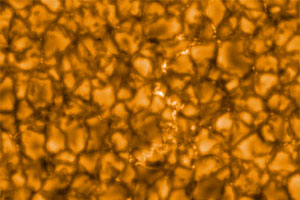 Extreme close-up of the Sun's visible surface,
Extreme close-up of the Sun's visible surface,
showing 'bubbling' cells of convecting gas--each the size of
Northern California. credit: Hinode JAXA/NASA/PPARCBy all accounts, a new cycle-Cycle 24-in solar activity has begun... something you probably didn't notice since the beginning of a solar cycle is quite subtle....
First things first: what is a solar cycle, and why is this one number 24? You've probably heard of sunspots and solar flares and disturbances in radio communications caused by solar activity, but had you noticed NOT hearing much about these things in the last two or three years?
The Sun exhibits a cyclic rise and fall in its level of magnetic activity. Being an enormous ball of roiling, circulating plasma (electrically charged gas), the Sun generates powerful magnetic fields in a way similar to how the circulating electricity in an electromagnet creates one.
Over the course of a solar cycle, the intensity and amount of magnetism generated by the Sun increases, like soup warming up on the stove, reaching a violent climax in which twisting, tangling magnetic fields break loose and release their energy in the form of solar flare explosions, coronal mass ejections, and tremendous heating of the solar atmosphere.
Sunspots are surface features formed by the presence of strong magnetic fields, and in general the number of sunspots that can be seen and counted indicate the level of magnetic activity on the Sun. For 400 years, since Galileo first started counting sunspots through his telescope, observers have kept track of sunspot counts, and over time a pattern in their number emerged. On average, the number of sunspot activity peaks every 11 years at a time called solar maximum.
